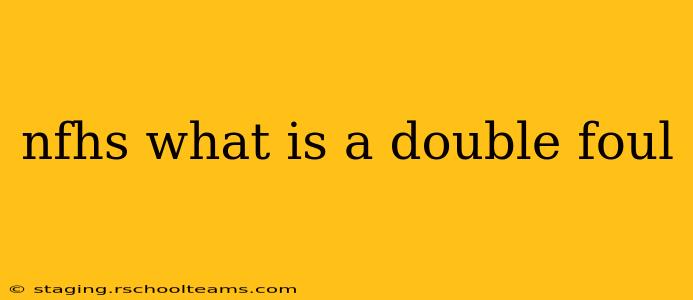In the National Federation of State High School Associations (NFHS) rulebook, a double foul occurs when two opposing players commit fouls against each other simultaneously. This isn't simply two fouls happening at the same time; it requires a direct and reciprocal action where both players are equally at fault. Understanding the nuances of a double foul is crucial for coaches, players, and officials alike. This article will clarify the definition and implications of a double foul under NFHS rules, addressing common questions.
What constitutes a simultaneous foul under NFHS rules?
A double foul is declared when two players commit fouls against one another within the same brief moment of action. The fouls don't have to be identical; they simply need to be mutual and occur almost instantaneously. Examples could include:
- Two players fighting for possession: Both players might commit a personal foul simultaneously while vying for a loose ball – one might hold, and the other might push.
- A collision during a play: During a fast break, two players might collide due to a lack of awareness or poor positioning, resulting in both committing fouls (e.g., illegal contact).
- Simultaneous physical contact: Two players could make simultaneous contact resulting in a charge and a blocking foul.
It's important to note that the officials must use their judgment. If one foul clearly precedes the other, even by a fraction of a second, it's unlikely to be called a double foul. The key is simultaneity and mutual fault.
What happens after a double foul is called?
The consequences of a double foul are generally straightforward:
- No free throws are awarded: Neither team gets free throws.
- Jump ball: A jump ball is usually conducted at the center of the court (or the nearest center spot), restarting play. The location of the jump ball depends on where the double foul occurred.
- Possession: The jump ball determines possession. This means that the team that committed the foul does not necessarily lose possession.
Can a double foul be a technical foul?
While unusual, it's theoretically possible for a double foul to involve a technical foul. This would occur if one of the simultaneous fouls was also a technical foul, such as unsportsmanlike conduct. In this situation, the technical foul would be assessed independently, with its standard penalty (e.g., free throws for the opposing team). The simultaneous personal fouls would still result in a jump ball.
What if one player commits a more serious foul?
If one foul is considerably more serious than the other (e.g., flagrant foul versus a minor contact foul), the officials will likely assess the fouls separately. The more serious foul would be penalized accordingly, overriding the concept of a double foul.
How do officials determine if it's a double foul?
Officials are trained to observe player actions carefully. They have to be decisive in assessing the nearly simultaneous occurrence of fouls and determining whether the fouls are mutually committed. Their judgment plays a significant role in calling a double foul. There's a degree of subjectivity involved, making consistency among officials crucial.
Are double fouls common in high school basketball?
Double fouls aren't exceptionally common but are a regular occurrence in the dynamic and often close-quarters environment of high school basketball. Their infrequent appearance is largely due to the high standard of simultaneity required.
Understanding double fouls under NFHS rules requires recognizing the criteria for simultaneity and the resulting jump ball. This clarification can enhance both players' and coaches' knowledge of this intricate aspect of the game. Remember to always consult the official NFHS rulebook for the most up-to-date and precise information.
